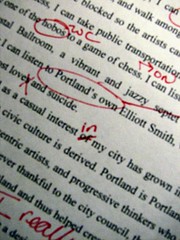There are probably as many ways to edit a story as there are to write one. Today, I’m thinking about “macro” edits—looking at structure and scene placement, rather than the individual words and style.
One of my favorites has been the scene chart, inspired by a post on Edittorrent. The original post suggested creating index cards for each scene, listing a  number of important features—everything from where and when the scene is set, to first and last lines, to “promises” made to the reader, to important details like descriptions. Then you could move the index cards around to resequence events or scenes, or play with the story without hurting your MS.
number of important features—everything from where and when the scene is set, to first and last lines, to “promises” made to the reader, to important details like descriptions. Then you could move the index cards around to resequence events or scenes, or play with the story without hurting your MS.
Like many of the commentators on the post, however, I used a spreadsheet to do this in a very small space. I also combined this with probably the most important thing I learned from Jack Bickham’s Scene & Structure—the structure of a scene and the importance of a scene goal—for the character, not just me as a writer.
When I used these techniques together, I found that the scenes that lacked a goal for the character (or a unique goal, as opposed to one that the character’s had four times now) were often the unfocused scenes I needed the most work on—or to cut altogether. I could also bring out hidden scene goals, find new ones to add layers to a scene and strengthen the scenes by enhancing the goals, conflict and disasters.
So here’s an example of the kind of scene chart I used, partially filled in for an imaginary story (anybody recognize the plot? Hint: it’s from an old card game). I didn’t use all of these columns myself (and if any of them aren’t clear, feel free to ask what I mean).
That’s just one thing I’ve tried, and I liked it so well, I’ll definitely use it in the future.
What do you think? Do you use a form of scene charts? What’s your favorite “macro” editing technique?
Photo credit: Aaron Brown
